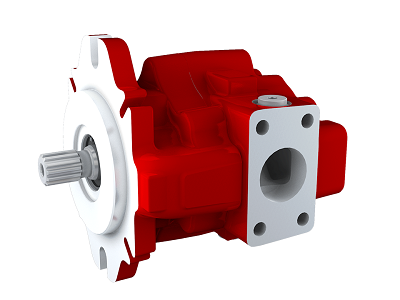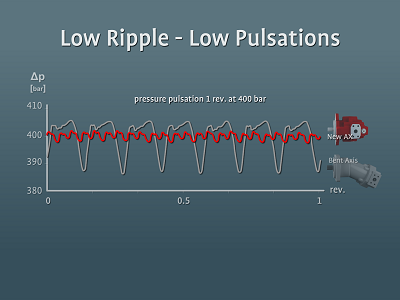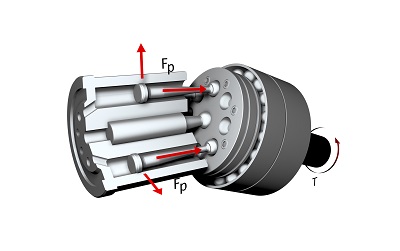Piston pumps and motors have been on the market for many years, and they are arguably one of the most important components in many hydraulic circuits. The basic design behind a conventional piston pump usually has seven or nine pistons that convert mechanical torque into oil pressure. In a piston motor, the process is reversed.

AX fixed displacement piston pumps and AXM motors are available in multiple sizes with displacements from 18 to 76 cc/rev.
Every project engineer has, without a doubt, experienced the limitations of piston pumps and motors: high-pressure ripple, and less-than-desired mechanical and volumetric efficiency, according to officials at Bucher Hydraulics, Elgin, Ill. In addition, the growing demand for electrically powered machines has exposed additional drawbacks such as noisy operation and minimum shaft speeds that must be fairly moderate when working at high pressure.
Applications that face the need for faster cycle rates, increased operating pressures, more-responsive dynamics and accurate flow and pressure control have already been handcuffed by the shortcomings of current piston pumps. Engineers normally compensate for these restrictions by using accumulators and valves with associated high energy losses and additional costs.
For these reasons, Bucher Hydraulics is introducing a new series of pumps that overcomes the limitations of conventional piston technology. Company officials say it is not just a further evolution of existing pump concepts, but rather it is a revolutionary design that offers better efficiency, excellent dynamics, low noise, and low minimum speed at high output torque.
The new AX piston pump and AXM piston motor work on the principle of balancing internal forces by having two rotating barrel plates facing each other, and each having 12 pistons. Thus, the units achieve a high power density and while limiting the axial forces, which need only a light bearing to handle the loads.
The models come in displacements from 18 to 76 cc/rev, and the company plans to extend the range up to 115 cc/rev in the near future. Maximum operating speed for the units is 3,600 rpm.
Sights on electrification

Tests show an 80% reduction in pressure pulsations in an AX size-24 pump running over 1 rev. and 400 bar, compared to a conventional bent-axis pump.
The characteristics of the Bucher Hydraulics AX pump were developed with a particular focus on construction machines powered by electric motors. The high volumetric and mechanical efficiency, low noise, low-pressure ripple, and minimum permissible speed of only 2 to 3 rpm, together with the possibility of bidirectional operation, make the AX pump well-suited for electrical and hybrid machines of the future.
For example, because as there is virtually no minimum speed limit, they are ideally suited for matching fixed-displacement AX units with variable-speed electric drives. Further, this high level of efficiency in electric-drive mobile machines is essential, as low power losses mean valuable battery capacity can be conserved.
Likewise the AX pump, with a balanced design and more pistons, produces a low pressure ripple and generates minimal noise over a wide range of speeds and pressures. In contrast, conventional axial-piston pumps produce considerable noise as alternating and widely fluctuating internal pump forces result in housing vibrations that ultimately transmit to the machine. When traditional hydraulic pumps are used with diesel engines, the problems of physical pulsation are barely noticeable. In inherently quiet electric-drive applications, that’s no longer acceptable.
The advantages offered by these models also come into play in winch applications. Winch operations, in general, are problematic because torque-ripple issues can hurt performance. Efficiency at start-up can be poor. And high-pressure performance can be lacking at low rotary speeds.
Standard AX pumps and motors can reach a working pressure of 450 bar. And with a low-speed range of just a few rpms, the AX motor has a starting efficiency of 99% versus the 60 to 65% of a conventional axial-piston unit. Performance can significantly increase thanks to precise and accurate crane movements. Crane slew drives can take advantages of these attributes, too.

The large, non-compensated forces in typical bent-axis motors need to be absorbed by extra-large ball or roller bearings. This increases the space required and makes integration into a machine more difficult.
Other industry applications can also benefit from the Bucher AX hydraulic pumps and motors characteristics of excellent energy efficiency and performance when the unit must start and run slowly under high load and pressure. In wheel motors, for instance, high power density and working pressure coupled with low permissible speed make the AXM motor the perfect alternative to gear motors. The minimum speed of two rpm brings new possibilities to mobile machines. Software tools let engineers conduct multiple iterations during the design phase, offering several options in different and lower gear ratios. For straight travel in vehicles such as crawler excavators, the volumetric efficiency of approximately 96% will permit an increase in ground speed.
Bucher Hydraulics
www.bucherhydraulics.com
Filed Under: Mobile Hydraulic Tips